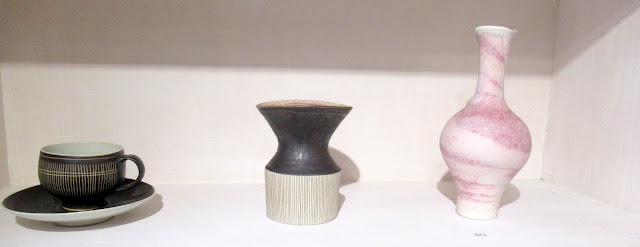It was a great pleasure seeing some of the work of Lucy Rie, one of the most influential potters of the 20th century.
Rie was taught by Adolf Loos and painter Oskar Kokoschka in Vienna. She went on to establish an in-depth knowledge of pottery glazes and techniques and gained an international reputation while based there. After Austria formed a union with Nazi Germany in 1938 Rie and her husband fled to London.
Her practice differed from the trends in England at the time, led by figures such as Bernard Leach and Michael Cardew. While followers of Leach embraced stoneware and earthenware, often in brown and yellow glazes, Rie remained loyal to the aesthetic of Viennese Modernism, and her continental preference for minimalism. While Leach's pottery was made in a traditional wood-fired kiln, Rie preferred the electric kiln. With this, she experimented with a much larger scope of colours, while limiting the forms of her pieces to tableware only.
Her mixed clay bottles with flaring necks, sgraffito bowls and vases with heavily pitted surfaces are best judged in the context of the modern environment of 20th century architecture and design as a whole. Rie's true functionalism was best expressed in her tablewares of the 50s and 60s, elegant tea and coffee sets with incised decoration and iron flecked salad bowls and lidded pots. In the last two decades of her life she concentrated on more decorative individual pieces. She rallied for ceramics holding just as high an importance as the rest of the arts.






















No comments:
Post a Comment